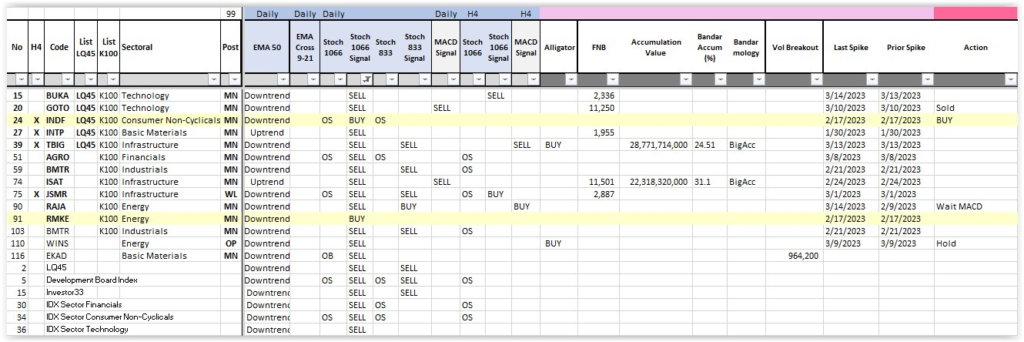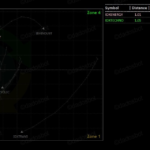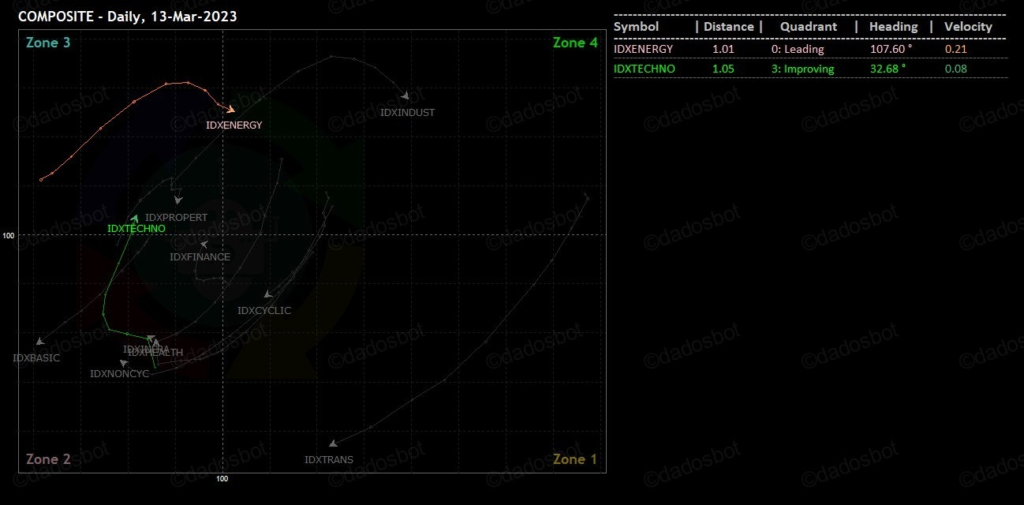Daily Analysis 20230315

March 15th, 2023
Good morning,
Dow closes more than 300 points higher, snaps 5-day losing streak as bank shares rebound
U.S. stocks rose Tuesday as investors bet the risk of contagion following the closures of Silicon Valley Bank and Signature Bank has been contained
Dow……32155 +336.3 +1.06%
Nasdaq11428 +239.3 +2.14%
S&P 500.3919 +63.5 +1.65%
FTSE…….7637 +88.5 +1.17%
Dax……..15233 +273.4 +1.83%
CAC……..7142 +130.2 +1.86%
Nikkei…..27833 -311.01 -1.11%
HSI………19696 +376.1 +1.95%
Shanghai.3269 +38.6 +1.20%
IDX…..6641.81 -145.14 -2.14%
LQ45….917.38 -22.46 -2.39%
IDX30…477.99 -12.08 -2.47%
IDXEnergy..2013.23 -61.82 -2.94%
IDX BscMat 1146.90 -13.66 -1.18%
IDX Indstrl.1147.89 -26.70 -2.27%
IDXNONCYC..719.53 -7.19 -0.99%
IDX Hlthcare1531.03 -5.73 -0.37%
IDXCYCLIC…804.96 -23.50 -2.84%
IDX Techno.5191.01 -164.63 -3.05%‼️
IDX Transp.1716.57 -70.29 -3.93%‼️
IDX Infrast….813.72 -16.19 -1.95%
IDX Finance1353.51 -29.92 -2.16%
IDX Banking1098.35 -31.18 -2.76%
IDX Property….673 -7.30 -1.07%
Indo10Yr.6.8707 -0.0497 -0.72%👍
ICBI….351.4897 +1.2731 +0.36%👍
US2Yr4.2462 +0.2304 +5.74%‼️
US5Yr 3.8478+0.1660 +4.51%‼️
US10Yr3.6850+0.1400+3.95%‼️
US30Yr.3.8050+0.1110+3.00%‼️
VIX…… 26.38 -2.79 -10.52%‼️
USDIndx103.5970 +0.0020+0.00%
Como Indx.264.67 -0.32 -0.12%
(Core Commodity CRB)
BCOMIN…156.73 -0.76 -0.48%
IndoCDS..105.25 – -%
(5-yr INOCD5) (07/11)
IDR…..15386.50 +8.50 +0.06%
Jisdor.15380.00 +6.00 +0.04%
Euro……1.0732 +0.00050 +0.05%
TLKM….26.38 +0.29 +1.11%
(4057)
EIDO……21.96 -0.18 -0.81%
EEM……37.92 +0.02 +0.05%
Oil….71.78 -2.91 -3.90%‼️
Gold1908.90 -7.70 -0.40%
Timah .23210.00 +298 +1.30%
(Closed 03/13)
Nickel..23062.50 -103.50 -0.44%
(Closed 03/14)
Silver…..21.81 -0.07 -0.32%
Copper.400.85 -3.35 -0.83%
Nturl Gas.2.5770 +0.1410 +5.79%
Ammonia 4323.33 -83.34 -1.89%
China
(Domestic Price)(03/13)
Coal price.180.00 -2.90 -1.59%
(Mar/Newcastle)
Coal price.187.00 -4.50 -2.35%
(Apr/Newcastle)
Coal price.192.95 -4.55 -2.30%
(May/Newcastle)
Coal price.199.45 -1.55 -0.77%
(Jun/Newcastle)
Coal price.141.00 +2.35 +1.69%
(Mar/Rotterdam)
Coal price 137.35 -1.35 -0.97%
(Apr/ Rotterdam)
Coal price 135.40 -2.45 -1.78%
(May/Rotterdam)
Coal price 134.90 -2.65 -1.93%
(Jun/Rotterdam)
CPO(May)…3982 -63 -1.56%
(Source: bursamalaysia.com)
Corn……..620.75 +7.25 +1.18%
SoybeanOil.56.18+0.32 +0.57%
Wheat…..696.25 +11.75+1.72%
Wood pulp…5650.00 -20 -0.35%
(Closed 03/14)
©️Phintraco Sekuritas
Broker Code: AT
Desy Erawati/ DE
Source: Bloomberg, Investing, IBPA, CNBC, Bursa Malaysia
Copyright: Phintraco Sekuritas
US rebound, Europe rebound, asia cuma IDX sama Nikkei yang merah dalem, Shanghai sama Hangseng ijo tebel, harusnya ikut ijo tebel hari ini
Oil drop, coal merah, gas rebound, metal2 merah kecuali timah, masih belum ok buat saham coal oil dan tambang2 mineral metal. Sabar…
IHSG – udah drop tutup gap dan kena fibo 78, waktunya rebound dan lanjut rally wave 3. indicator oscillators, jelas jelek semua karena baru terjun, BD flat FF dist, ada reg bull div di CCI, yang bottom fishing boleh jalan, yang cari reversal tunggu konfirmasi dulu, minimal konfirmasi divergence kalopun belum ok di oscillators
Technology dan Healthcare, kemaren pas market merah dalem healthcare jadi ganjel, semoga lanjut
Stochastic Buy Signal: INDF RMKE
MACD Buy Signal: UNVR MIKA
Alligator Buy Signal: TBIG PNBN WINS











